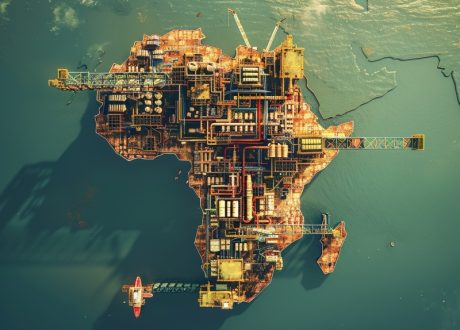
Report highlights 2 Egyptian projects among major clean energy ventures in N.Africa
A report by Energy Capital & Power highlighted two Egyptian projects – Suez Wind Power ...

The World Bank rail projects in Egypt aim to reduce the climate and environmental impacts of transport by moving more people and goods from roads to rail—a change that can’t come fast enough. In the Middle East and North Africa Region, air pollution is responsible for 270,000 premature deaths every year, which bear a huge economic cost of around 2 percent of GDP per year. A large culprit of this pollution is transport emissions. In Egypt, the proliferation of private cars, taxis and trucks on the road triggered a 75% increase in transport emissions between 2005 and 2019, demonstrating how rapid motorization comes with serious implications for health and the environment.
The World Bank is providing two loans to the Egyptian government to help the Egyptian National Railways (ENR) tackle the transport emission issue as well as passenger safety and moving freight.
Serving the end, the World Bank decided to extend a $440-million loan will support safety and service quality improvements along the Alexandria-Cairo-Nag Hammadi railway corridor, while another $400-million project addresses rail logistics.
“Railways are fascinating but involve complex systems. When you try to understand the challenges facing Egypt’s railways, you have to look at all the pieces of the puzzle together: tracks, signaling, stations, rolling stock, safety protocols, staff training, regulation, etc. If any of these components falls short, the entire system suffers,” said Ibrahim Dajani, Practice Manager for Transport in the World Bank’s Middle East and North Africa region. “Our rail projects look at all these elements comprehensively to ensure we can deliver real and lasting improvements.”
Trucks still move the vast majority of Egypt’s freight, about 96 percent of it. Railways move only about 1.9 percent. Part of the reason is that only three freight trains per direction per day can travel between Alexandria’s seaport and the 6th of October dry port outside Cairo. Capacity constraints on rail, roads, and the Nile River weaken the links between ports, cities, and industrial zones. These kinds of inefficiencies are costly, and improving logistics is necessary to expand trade competitiveness. Further, a lack of targeted regulations distorts the market and gives road transport an unfair economic advantage over rail.
The Bank-supported Cairo Alexandria Trade Logistics Development Project will ease the pressure by co-financing the creation of a railway bypass around Greater Cairo, which will greatly increase network capacity and reduce the competition between freight and passenger services.
The project will also help modernize railway policies and regulations. Right now, publicly-owned ENR is the only operator that can carry freight on the rail network. A new system will change that and allow private operators to use railway tracks in exchange for a toll, which will be paid directly to ENR. By encouraging private operators to enter the freight rail market, these reforms are expected to boost capacity and efficiency across the network.
Together, these initiatives will help improve the rail system and move freight on a larger, more reliable network, cutting transit delays. Egyptian rail has already more than quadrupled the amount of freight it moves to approximately 25 million tons annually, up from 4.6 million tons just five years ago.
Ninety percent of Egyptian National Railways’ operations involve moving passengers, and they, particularly low-income riders, will benefit from safer, more reliable, and faster services. The World Bank’s financing will lead to railway reforms that improve the Egyptian National Railways’ (ENR) safety and efficiency to cut down on air pollution, speed access to jobs and services, and make rail service safe and accessible for all.
Safety and service quality are driving much of the engagement between the World Bank, the Egyptian Ministry of Transport, and ENR. This includes extensive upgrades to the signaling system along the Alexandria-Cairo-Nag Hammadi alignment, an all-important 763-kilometer railway corridor that connects densely-populated areas across the country.
But the concept of safety extends beyond hard infrastructure to the feeling passengers get when they ride Egypt’s trains. This involves, for instance, creating a stronger safety culture with a focus on safe operations and maintenance. As part of this, the World Bank is supporting the creation of a database for safety incidents, which will help ENR monitor and analyze incidents in a more systematic way to prevent reoccurrence. The Bank is also supporting ENR’s efforts to rethink the design of stations and level crossings, especially to enhance the “beyond-rail” elements of the design – safety, security and accessibility – utilizing design principles from best international practice.
In parallel, to ensure these initiatives translate into lasting results, the Bank is working with the Egyptian Ministry of Transport and the Korean experts to facilitate local training and knowledge exchange. The objective is to help train the next generation of Egyptian planners, engineers and managers, and to enhance the country’s technical capacity across the railway sector.
“The Government of Egypt has invested significantly in the last few years to modernize its transport system. Railways are important to Egyptians, and have great potential for the economy,” said Salma Abdel Fattah, the World Bank Transport Specialist co-leading the project. “But decades of underinvestment have taken a heavy toll on rail infrastructure and services. We are excited to work with the Ministry of Transport and ENR to build a better future for the system and make a safer, more efficient railway system a reality.”
A report by Energy Capital & Power highlighted two Egyptian projects – Suez Wind Power ...
The opening concert of the Annual Meeting 2025 in Davos-Klosters will address the pressing issues ...
Juhayna Food Industries proudly announced that its agricultural arm, El Enmaa for Agricultural Development, has ...


اترك تعليقا